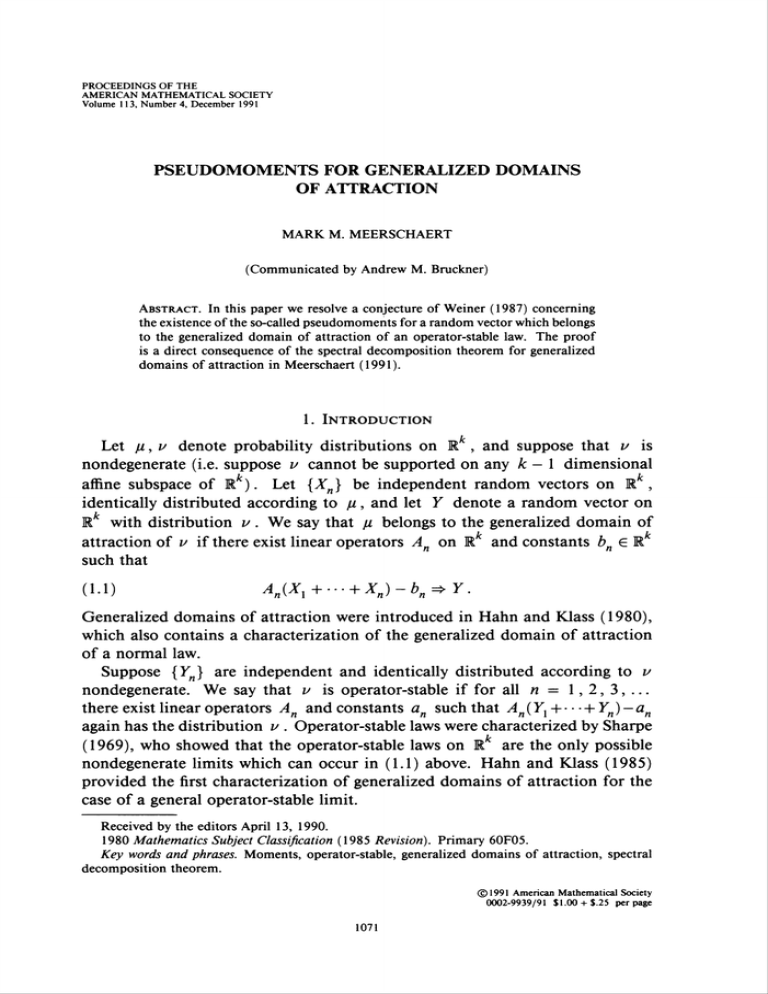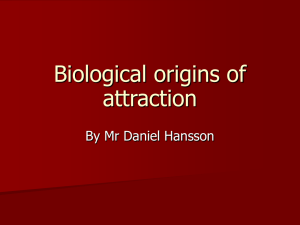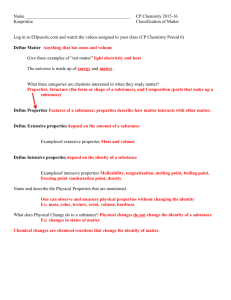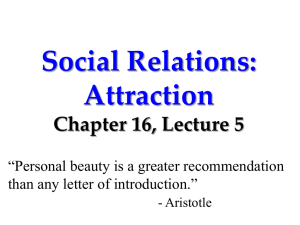PSEUDOMOMENTS FOR GENERALIZED DOMAINS OF ATTRACTION
advertisement

PROCEEDINGS OF THE
AMERICAN MATHEMATICAL SOCIETY
Volume 113, Number 4, December 1991
PSEUDOMOMENTS FOR GENERALIZED DOMAINS
OF ATTRACTION
MARK M. MEERSCHAERT
(Communicated
by Andrew M. Bruckner)
Abstract.
In this paper we resolve a conjecture of Weiner (1987) concerning
the existence of the so-called pseudomoments for a random vector which belongs
to the generalized domain of attraction of an operator-stable law. The proof
is a direct consequence of the spectral decomposition theorem for generalized
domains of attraction in Meerschaert (1991).
1. Introduction
Let p, v denote probability distributions on R , and suppose that v is
nondegenerate (i.e. suppose v cannot be supported on any k - 1 dimensional
k
k
affine subspace of R ). Let {Xn} be independent random vectors on B ,
identically distributed according to p, and let Y denote a random vector on
R with distribution v . We say that p belongs to the generalized domain of
attraction of v if there exist linear operators An on R and constants bn £ R
such that
(1.1)
An{xx+...
+ Xn)-bn^Y.
Generalized domains of attraction were introduced in Hahn and Klass (1980),
which also contains a characterization of the generalized domain of attraction
of a normal law.
Suppose {Yn} are independent and identically distributed according to v
nondegenerate. We say that v is operator-stable if for all n = 1,2,3,...
there exist linear operators An and constants an suchthat An(Yx-\-r-Yn)-an
again has the distribution v . Operator-stable laws were characterized by Sharpe
(1969), who showed that the operator-stable laws on R are the only possible
nondegenerate limits which can occur in (1.1) above. Hahn and Klass (1985)
provided the first characterization of generalized domains of attraction for the
case of a general operator-stable limit.
Received by the editors April 13, 1990.
1980 Mathematics Subject Classification (1985 Revision). Primary 60F05.
Key words and phrases. Moments, operator-stable,
decomposition theorem.
generalized domains of attraction,
spectral
©1991 American Mathematical Society
0002-9939/91 $1.00+ $.25 per page
1071
1072
M. M. MEERSCHAERT
Operator-stable laws and generalized domains of attraction are a natural
generalization of stable laws and domains of attraction in E . In the onedimensional case, Feller (1971) provided an elegant description of the moment
behavior of stable laws and domains of attraction using the tools of regular
variation. The extension of these results to R was made more difficult due
to the fact that the linear operators An in ( 1.1 ) above many contain rotations
as well as scaling. Complete results for operator-stable laws are contained in
Meerschaert (1990). Moment results for generalized domains of attraction appeared in Meerschaert (1991), along with an alternative characterization of the
generalized domain of attraction of an operator-stable law based on multivariate
regular variation. These results are directly analogous to the one-dimensional
case as described in Feller (1971).
Associated with every operator-stable law v there is a (not necessarily unique)
linear operator B on R called an exponent of v which plays the same role as
the characteristic exponent of a one-dimensional stable law. If {Yn} are i.i.d.
as before then n ( Yx+ ■■• + Yn) - an has distribution v for all n , for some
an £ R . Here n
= exp(Blogn) where exp is the exponential operator defined by exp(A) = I + A + A2/2\ + A3/3\ + --- . The path behavior of tB can best
be understood as a reparametrization [log t = s] of the general solution to a linear system of ordinary differential equations. The norming operators n
may
perform rotations as well as scaling. In order to incorporate this geometry into
the study of moment behavior for operator-stable laws and generalized domains
of attraction, Weiner (1987) introduced the concept of pseudomoments.
Given a nondegenerate random vector Z defined on a finite dimensional
Euclidean space, and a nonsingular linear operator A on the same space, the
,4-pseudomoment of order p of Z is defined by
(1.2)
E(Z,A,p)=
f°° Pr[\\rA/pZ\\>\]dt.
Jo
For Y operator-stable with exponent B, Weiner showed that E(Y, B, p) < oo
for all 0 < p < 1. If Y is Gaussian then E(Y, B, p) < oo for all p > 0, and
otherwise E(Y, B, p) = oo for p > 1 .
Now if ( 1.1 ) holds in the special case An = n
for all n , where B is an
exponent of v , we say that p belongs to the domain of normal attraction of
v. Weiner showed that for X in the domain of normal attraction of Y, the
pseudomoment E(X, B, p) < oo for 0 < p < 1, and for p > 1 the pseudomoment converges in the case of a normal limit Y and diverges otherwise.
Weiner goes on to conjecture that the same results hold (suitably modified in
the case p = I ) when X belongs to the generalized domain of attraction of Y .
The purpose of this paper is to resolve Weiner's conjecture. The conjecture as
it stands is false, due to the fact that the norming operators in (1.1) can contain
rotations which are not allowed in the special case of normal attraction. However, it is true that similar pseudomoment results can be obtained for any X in
the generalized domain of attraction of an operator-stable law after an appro-
PSEUDOMOMENTS FOR GENERALIZED DOMAINS OF ATTRACTION
1073
priate rotation. In the next section we will provide a corrected statement of the
general pseudomoment results, based on the spectral decomposition theorem of
Meerschaert (1991).
2. Results
As before, let {Xn} denote i.i.d. random vectors on R with distribution p,
and let Y denote a nondegenerate random vector on R with operator-stable
distribution v . Associated with any operator-stable law v there is a direct sum
decomposition R = Vx®- ■■®Vrncalled the spectral decomposition, introduced
in Meerschaert (1990). If B is any exponent of v , let kx ■■-km denote the real
spectrum of B, i.e. the real parts of eigenvalues of B . Then Vi is the direct
sum of the generalized eigenspaces of B for eigenvalues with real part equal
to ki. Since Vx■■■Vn are ß-invariant subspaces it is obvious that they are also
n~~ invariant.
If (1.1) holds for some sequence of norming operators An having the property that Vx---Vm are An-invariant subspaces for all n , we say that p is spectrally compatible with v . If p belongs to the domain of normal attraction of
v , then obviously p is spectrally compatible with v . This is not true in the
case of generalized domains of attraction; however the spectral decomposition
theorem of Meerschaert (1991) states that for every p in the generalized domain of attraction of v operator-stable, there exists a linear operator T on R
such that Tp is spectrally compatible with v . The linear operator T is simply
a change of coordinates, and so we may take T to be orthogonal.
Theorem. If p is spectrally compatible with v then:
(i) E(Xn , B , p) < oo for all 0 < p < 1 ;
(ii) if v has a nonnormal component then E(Xn , B, p) = oo for all p > 1.
If p = 1 , or if p > 1 and v is purely Gaussian, then the pseudomoment will
be finite for some p and infinite for some others. The choice of exponent B
does not alter the results of the theorem; however, it does effect the numerical
value of the pseudomoment in the case of convergence. By virtue of the spectral decomposition theorem, we obtain the following result, which characterizes
pseudomoments for generalized domains of attraction.
Corollary. If p belongs to the generalized domain of attraction of v then there
exists an orthogonal transformation T on R such that:
(i) E(TXn , B, p) < oo for all 0 < p < 1 ;
(ii) // v has a nonnormal component then E(TXn, B,p)
p>\.
— oo for all
We remark that in the case of v normal, every p in the generalized domain
of attraction of v is automatically spectrally compatible since the spectral decomposition of v consists of a single component.
M. M. MEERSCHAERT
1074
3. Proof
of the Theorem
Suppose that v is operator-stable on R and B is an exponent of v . Sharpe
(1969) shows that the real spectrum kx ■■-km of B is contained in the interval
[1/2, oo). If p belongs to the generalized domain of attraction of u , and if
p is spectrally compatible with v , then by Theorem 4.1 of Meerschaert (1991)
we have that
(3.1)
logp„x||/logn^-A;.
for all x ± 0 in Vj, where Vx---Vm is as before the spectral decomposition
relative to v . In other words «^H^xH —►
0 for 0 < p < ki and np||^4nJ£:||—>oo
for p > kr A computation shows that for x g K
(3.2)
logllAll/logi^A,.
as t -* oo for all x ^ 0 in V¡. See, for example, Meerschaert (1990).
Now if ( 1.1) holds, then by the standard convergence criteria for triangular
arrays we have np{A~ dx} —*4>{dx} , where </>is the Levy measure of the
limit distribution v. Let H denote the ^-continuity set {x : \\x\\ > 1}. The
ß-pseudomoment of order p of Xn is
f°°
/
Jo
Bl
Pr[||r B'pXJ\>l]dt
roo
(3.3)
=/
Jo
Pr[\\s-BXJ\>l]psp-xds
roo
= /
p(s //)/?/
ds.
JO
By the above arguments we have that \\Ann(1+e)JÎ|| -♦ oo and \\Ann(1_£)S|| -> 0
uniformly on compact sets for all e > 0 small. Thus as n —>oo, we have
np(n{x+e)BH) = np(A~xAnn{x+e)BH) - 0 and np(n{x~E)BH) -* oo (assuming
that v is nonnormal, i.e. that cp is not the zero measure). By a change of
variable, we have nx+ p(nBH) -> oo and nx~ p(nBH) —>0 for all S > 0
small, or in other words,
(3.4)
log p(nBH)/log n-+ 1.
By an easy continuity argument, the same holds with n replaced by / real.
Now if p > 1 and v is nonnormal, then (choose ô < p - 1) for some s0 > 0
we have p(s H) > s
for all s > sQ and so the pseudomoment is infinite. If
0 < p < 1 then (choose S < 1 - p) we have p(s H) > s + for all large s,
and so the pseudomoment converges. This concludes the proof.
References
Araujo, A. and E. Giné (1980), The central limit theorem for real and Banach valued random
variables, Wiley, New York.
Feller, W. (1971), An introduction to probability theory and its applications, Wiley, New York.
PSEUDOMOMENTSFOR GENERALIZED DOMAINS OF ATTRACTION
1075
Hahn, M. and M. Klass (1980), Matrix normalization of sums of random vectors in the domain of
attraction of the multivariate normal, Ann. Probab. 8, 262-280.
Hahn, M. and M. Klass (1985), Affine normability of partial sums of I.I.D. random vectors: A
characterization, Z. Wahrsch. Verw. Geb. 69, 479-505.
Meerschaert, M. (1991), Spectral decomposition for generalized domains of attraction, Ann. Probab.
19.
_,
(1990), Moments of random vectors which belong to some domain of normal attraction, Ann.
Probab. 18, 870-876.
Sharpe, M. (1969), Operator-stable probability distributions on vector groups, Trans. Amer. Math.
Soc. 136,51-65.
Weiner, D. (1987), On the existence and convergence of pseudomoments for variables in the domain
of normal attraction of an operator-stable distribution, Proc. Amer. Math. Soc. 101, 521-528.
Department
of Mathematics,
Albion College,
Albion, Michigan
49224





